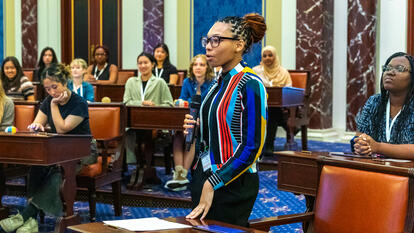Wellesley Professor and First-Time Marathoner Produces Running-Themed Science Podcast

Since he came to Wellesley 11 years ago, Adam Van Arsdale, associate professor of anthropology, has watched the Boston Marathon runners from the sidelines. This year, for the first time, he is a member of the pack and is wearing bib number 29384.
But just finishing the marathon is not Van Arsdale’s only goal. He will lace up his running shoes and take his spot at the start line to raise money for Boston’s Museum of Science. An equally significant purpose is academic: Van Arsdale—who teaches human evolution, human genetics, osteology, and forensic anthropology—has used his training regimen to create content for his podcast series, “Running for Science: Science for Running,” in which he explores the evolution of human locomotion and energetics and interviews researchers in the field.
“I’ve lived here for 11 years and have not missed watching the marathon and cheering on the mobility-impaired athletes, the elite athletes, and everybody else,” said Van Arsdale, who hasn’t run a long-distance race before and admits he doesn’t exactly love running. “I’ve been intrigued by the possibility of running it myself.”
Two years ago, Van Arsdale’s friend and fellow anthropologist Jeremy DeSilva, associate professor of anthropology at Dartmouth College, ran the marathon to raise money for the museum. Van Arsdale decided to do the same, and at the same time use the marathon and his training to explore the biomechanics of human running in an evolutionary context. “My goal is to take science from behind the glass case and make it more relatable to people,” he said. “Everybody understands running but not necessarily from the point of view of evolution.”
The podcasts include discussions with 11 scientists who have studied the evolutionary history of running—the human gait, fossil foot trails, human locomotor anatomy, metabolism, and the neurobiology of running.
Van Arsdale knew a marathon would pose physical challenges for him. In high school and college he swam competitively, but running for miles on a hard surface is different from gliding through water. “Running and swimming require you to use different muscles,” he said. “Plus, I’m older. As I trained and eased into running during my training, I learned about rest and recovery, especially for the knees and ankles, and the need to ice down after a training run and take ibuprofen—that’s important.”
He started his training several months ago, running from his home in Natick to campus, or around Lake Waban or the campus track, gradually building up his mileage and increasing his stamina. (His dog, Clifford, loped along beside him on some of his shorter training runs.) At the peak of his training, Van Arsdale averaged close to eight miles a day; his longest run was 16 miles.
In January, Van Arsdale felt fit enough to run a half-marathon. That’s when he ran into a major problem: He pulled a muscle in his right leg, in a region near the hip and along the thigh, and had to stop running for five weeks (he swam to keep in shape). Eventually, he returned to his training regimen and regained his stamina.
Today, he will put his body to the test. “I’ve trained well,” he said. “The marathon is intimidating, but it’s also very exciting.”



